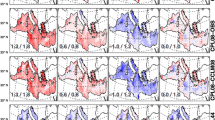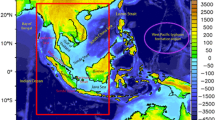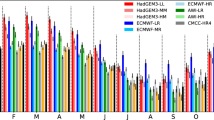Abstract
Air–sea ice–ocean interactions in the Ross Sea sector form dense waters that feed the global thermohaline circulation. In this paper, we develop the new limited-area ocean–sea ice–atmosphere coupled model TANGO to simulate the Ross Sea sector. TANGO is built up by coupling the atmospheric limited-area model MAR to a regional configuration of the ocean–sea ice model NEMO. A method is then developed to identify the mechanisms by which local coupling affects the simulations. TANGO is shown to simulate realistic sea ice properties and atmospheric surface temperatures. These skills are mostly related to the skills of the stand alone atmospheric and oceanic models used to build TANGO. Nonetheless, air temperatures over ocean and winter sea ice thickness are found to be slightly improved in coupled simulations as compared to standard stand alone ones. Local atmosphere ocean feedbacks over the open ocean are found to significantly influence ocean temperature and salinity. In a stand alone ocean configuration, the dry and cold air produces an ocean cooling through sensible and latent heat loss. In a coupled configuration, the atmosphere is in turn moistened and warmed by the ocean; sensible and latent heat loss is therefore reduced as compared to the stand alone simulations. The atmosphere is found to be less sensitive to local feedbacks than the ocean. Effects of local feedbacks are increased in the coastal area because of the presence of sea ice. It is suggested that slow heat conduction within sea ice could amplify the feedbacks. These local feedbacks result in less sea ice production in polynyas in coupled mode, with a subsequent reduction in deep water formation.

















Similar content being viewed by others
References
Bailey DA, Lynch AH (2000) Development of an Antarctic regional climate system model. Part I: Sea ice and large-scale circulation. J Clim 13:1337–1349
Bailey DA, Lynch AH, Arbetter TE (2004) Relationship between synoptic forcing and polynya formation in the Cosmonaut Sea: 2. Regional Climate Model Simulation. J Geophys Res 109:C04023
Barnier B, Madec G, Penduff T, Molines J-M, Treguier A-M, Le Sommer J, Beckmann A, Biastoch A, Böning C, Dengg J, Derval C, Durand E, Gulev S, Remy E, Talandier C, Theetten S, Maltrud M, McClean J, De Cuevas B (2006) Impact of partial steps and momentum advection schemes in a global ocean circulation model at eddy-permitting resolution. Ocean Dyn 56:543–567
Beckmann A, Goosse H (2003) A parametrization of ice shelf–ocean interaction for climate models. Ocean Model 5:157–170
Beranger K, Barnier B, Gulev S, Crepon M (2006) Comparing 20 years of precipitation estimates from different sources over the world ocean. Ocean Dyn 56:104–138
Bindoff N, Willebrand J, Artale V, Cazenave A, Gregory J, Gulev S, Hanawa K, Le Quéré C, Levitus S, Nojiri Y, Shum CK, Talley LD, Unnikrishnan AS (2007) Climate Change 2007: the physical science basis. Contribution of Working Group I to the fourth assessment report of the intergovernmental panel on climate change. Observations: oceanic climate change and sea level. Cambridge University Press, Cambridge
Briegleb B, Ramanathan V (1982) Spectral and diurnal variations in clear sky planetary Albedo. J Appl Meteorol 21:1160–1171
Brodeau L, Barnier B, Treguier A-M, Penduff T, Gulev S (2009) An ERA40 based atmospheric forcing for global ocean circulation models. Ocean Model 31:88–104
Broecker WS, Peacock SL, Walker S, Weiss R, Fahrbach E, Schroeder M, Mikolajevicz U, Heinze C, Key R, Peng T-H, Rubin S (1998) How much deep water is formed in the Southern Ocean? J Geophys Res 103(C8):15833–15843
Bromwich DH, Chen B, Hines KM (1998) Global atmospheric impacts induced by year-round open water adjacent to Antarctica. J Geophys Res Atmos 103(D10)
Budillon G, Pacciaroni M, Cozzi S, Rivaro P, Catalano G, Ianni C, Cantoni C (2003) An Optimum multiparameter mixing analysis of the shelf waters in the Ross Sea. Antarct Sci 15:105–118
Budillon G, Rintoul SR (2003) Fronts and upper ocean thermal variability south of New Zeland. Antarct Sci 15:141–152
Cailleau S (2004) Validation de méthodes de contraintes aux frontières d’un modèle océanique: application à un modèle hauturier de l’Atlantique Nord et à un modèle régional du Golfe de Gascogne. PhD thesis, Universite Joseph Fourier, Grenoble 1, France
Carmack E (1977) Water characteristics of the Southern Ocean south of the Polar Front. A voyage of discovery
Carrasco J-F, Bromwich D, Monaghan A (2003) Distribution and characteristics of mesoscale cyclones in the Antarctic: Ross Sea Eastward to the Weddel Sea. Mon Weather Rev 131:289–301
Cavalieri DJ, Parkinson CL (2008) Antarctic sea ice variability and trends, 1979–2006. J Geophys Res Oceans 113(C7):C07004
Chan JCL, Duan Y, Shay LK (2001) Tropical cyclone intensity change from a simple ocean–atmosphere coupled model. J Atmos Sci 58(2):154–172
Chiang JCH, Bitz CM (2005) Influence of high latitude ice cover on the marine Intertropical Convergence Zone. Clim Dyn 25(5):477–496
Collins WD, Bitz CM, Blackmon ML, Bonan GB, Bretherton CS, Carton JA, Chang P, Doney SC, Hack JJ, Henderson TB, Kiehl JT, Large WG, McKenna DS, Santer BD, Smith RD (2006) The community climate system model version 3 (CCSM3). J Clim 19(11):2122–2143
Comiso JC (2000) Variability and trends in Antarctic surface temperatures from in situ and satellite infrared measurements. J Clim 13:1674–1696
Drakkar Group: Barnier B, Brodeau L, Le Sommer J, Molines J-M, Penduff T, Theetten S, Treguier A-M, Madec G, Biastoch A, C, B, Dengg J, Gulev S, Bourdallé Badie R, Chanut J, Garric G, Alderson S, Coward A, de Cuevas B, Haines K, Smith G, Drijfhout S, Hazeleger W, Severijns C, Myers P (2007) Eddy permitting ocean circulation hindcasts of past decades. CLIVAR Exchanges 12-3:8–10
Dufresne J-L, Grandpeix J-Y (1996) Raccordement des modèles Thermodynamiques de glace, d’océan, et d’atmosphère - Note interne 205. Technical report, Laboratoire de Météorologie Dynamique (LMD), France
Ebert EE, Curry JA (1993) An intermediate one-dimensional thermodynamic sea ice model for investigating ice–atmosphere interactions. J Geophys Res 98:10085–10109
Eisen O, Frezzotti M, Genthon C, Isaksson E, Magand O, Broeke MR, Dixon DA, Ekaykin A, Holmlund P, Kameda T, Karlof L, Kaspari S, Lipenkov VY, Oerter H, Takahashi S, Vaughan DG (2008) Ground-based measurements of spatial and temporal variability of snow accumulation in East Antarctica. Rev Geophys 46(2)
Fichefet T, Goosse H (1999) A numerical investigation of the spring Ross Sea polynya. Geophys Res Lett 26(8)
Fichefet T, Morales Maqueda MA (1997) Sensitivity of a global sea ice model to the treatment of ice thermodynamics and dynamics. J Geophys Res 102(C3):12609–12646
Fichefet T, Morales Maqueda MA (1999) Modelling the influence of snow accumulation and snow-ice formation on the seasonal cycle of the Antarctic sea-ice cover. Clim Dyn 15:251–268
Gallée H (1998) Simulation of blowing snow over the Antarctic ice sheet. Ann Glaciol 26:203–206
Gallée H (1995) Simulation of the mesocyclonic activity in the Ross Sea, Antarctica. Mon Weather Rev 123:2050–2069
Gallée H, Guyonmarc’h G, Brun E (2001) Impact of snow drift on the Antarctic ice sheet surface mass balance: possible sensitivity to snow-surface properties. Boundary Layer Meteorol 99:1–19
Gallée H, Peyaud V, Goodwin I (2005) Simulation of the net snow accumulation along the Wilkes Land transect, Antarctica, with a regional climate model. Ann Glaciol 41:1–6
Gallée H, Schayes G (1994) Development of a three-dimensional meso-gamma primitive equations model, Katabatic winds simulation in the area of Terra Nova Bay, Antarctica. Mon Weather Rev 122:671–685
Genthon C, Krinner G, Sacchettini M (2003) Interannual Antarctic tropospheric circulation and precipitation variability. Clim Dyn 21:289–307
Giorgi F, Mearns O (1999) Introduction to special section: regional climate modeling revisited. J Geophys Res 104(D6):6335–6352
Gordon A, Comiso J (1988) Polynyas in the southern ocean. Sci Am 258:90–97
Grenfell TC, Perovich DK (1984) Spectral albedos of sea ice and incident solar irradiance in the Southern Beaufort Sea. J Geophys Res 89:3573–3580
Griffies S, Biastoch A, B“oning C, Bryan F, Danabasoglu G, Chassignet E, England M, Gerdes R, Haak H, Hallberg R, Hazeleger W, Jungclaus J, Large WG, Madec G, Pirani A, Samuels BL, Scheinert M, Gupta AS, Severijns CA, Simmons HL, Treguier A-M, Winton M, Yeager S, Yin J (2009) Coordinated ocean-ice reference experiments (COREs). Ocean Model 26(1-2):1–46
Heinemann G, Klein T (2003) Simulations of topographically forced mesocyclones in the Weddel Sea and the Ross Sea Region of Antarctica. Mon Weather Rev 131:302–316
Holland MM, Raphael MN (2006) Twentieth century simulation of the southern hemisphere climate in coupled models. Part II: sea ice conditions and variability. Clim Dyn 26(2):229–245
Huffman GJ, Adler RF, Arkin P, Chang A, Ferraro R, Gruber A, Janowiak J, McNab A, Rudolf B, Schneider U (1997) The Global Precipitation Climatology Project (GPCP) combined precipitation dataset. Bull Am Meteorol Soc 78(1):5–20
Jongma JI, Driesschaert E, Fichefet T, Goosse H, Renssen H (2009) The effect of dynamic-thermodynamic icebergs on the Southern Ocean climate in a three-dimensional model. Ocean Model 26(1–2):104–113
Jourdain NC, Gallée H (2010) Influence of the orographic roughness of glacier valleys across the Transantarctic Mountains in an atmospheric regional model. Clim Dyn (published online)
Kurtz DD, Bromwich DH (1985) A recurring, atmospherically forced polynya in Terra Nova Bay. Antarct Res Ser 43:493–508
Large WG, Yeager SG (2004) Diurnal to decadal forcing for ocean and sea-ice model: The data sets and flux climatologies, TN-460. Technical report, National Center for Atmospheric Research (NCAR), US
Lefebvre W, Goosse H (2008) Analysis of the projected regional sea-ice changes in the Southern Ocean during the twenty-first century. Clim Dyn 30(1):59–76
Lemarié F, Marchesiello P, Debreu L (2010) Global-in-time Schwarz methods applied to Two-Way Ocean-Atmosphere coupling: a study of tropical cyclone Erica. In preparation for J Geophys Res
Lengaigne M, Madec G, Bopp L, Menkes C, Aumont O, Cadule P (2009) Bio-physical feedbacks in the Arctic Ocean using an Earth System model. Geophys Res Lett 36:L21602
Luo JJ, Masson S, Behera S, Delecluse P, Gualdi S, Navarra A, Yamagata T (2003) South Pacific origin of the decadal ENSO-like variation as simulated by a coupled GCM. Geophys Res Lett 30(24):2250
Madec G (2008) NEMO, the ocean engine. Technical report, Institut Pierre Simon Laplace (IPSL), France
Mathiot P (2009) Influence du forçage atmosphérique sur la représentation de la glace de mer de des eaux de plateau en Antarctique dans une étude de modélisation numérique. PhD thesis, Université Joseph Fourier, Grenoble 1
Mathiot P, Barnier B, Gallée H, Molines J-M, Le Sommer J, Juza M, Penduff T (2010a) Introducing katabatic winds in global ERA40 fields to simulate their impact on the Southern Ocean and sea-ice. Ocean Model (published online)
Mathiot P, Jourdain NC, Barnier B, Gallée H, Molines J-M, Le Sommer J (2010b) Sensitivity of coastal polynyas and high salinity shelf water production in the Ross Sea, Antarctica, to the atmospheric forcing. Ocean Dyn (in revision)
Morales Maqueda MA, Willmott AJ, Biggs NRT (2004) Polynia dynamics: a review of observations and modeling. Rev Geophys 42:1–37
Morcrette JJ (2002) Assessment of the ECMWF Model cloudiness and surface radiation fields at the ARM SGP site. Mon Weather Rev 130:257–277
Noone D, Simmonds I (2004) Sea ice control of water isotope transport to Antarctica and implications for ice core interpretation. J Geophys Res Atmos 109(D7):D07105
Olbers D, Hellmer H (2009) A box model of circulation and melting in ice shelf caverns. Ocean Dyn 60:141–153
Orsi AH, Johnson GC, Bullister JL (1999) Circulation, mixing, and production of Antarctic Bottom Water. Prog Oceanogr 43(1):55–109
Parish TR, Bromwich DH (1991) Continental-scale simulation of the Antarctic Katabatic Wind Regime. J Clim 4:135–146
Rampal P, Weiss J, Marsan D, Lindsay R, Stern H (2008) Scaling properties of sea ice deformation from buoy dispersion analysis. J Geophys Res 113:C03002
Randall DA, Wood RA, Bony S, Colman R, Fyfe J, Kattsov V, Pitman A, Shukla J, Srinivasan RJ, Stouffer R, Sumi A, Taylor KE (2007) Climate Models and Their Evaluation. In: Solomon S, Qin D, Manning M, Chen Z, Marquis M, Averyt KB, Tignor M, Millers HL (eds) Climate Change 2007: The Physical Science Basis. Contribution of the Working Group I to the Fourth Assessment Report of the Intergovernmental Pannel on Climate Change. Cambridge University Press, Cambridge
Renner AHH, Heywood KJ, Thorpe SE (2009) Validation of three global ocean models in the Weddell Sea. Ocean Model 30:1–15
Rignot E, Jacobs SS (2002) Rapid bottom melting widespread near Antarctic ice sheet grounding lines. Science 296(5575):2020
Shine KP, Henderson-Sellers A (1985) The sensitivity of a thermodynamic sea ice model to changes in surface albedo parameterization. J Geophys Res 90:2243–2250
Stearns CR, Weidner GA (1992) Antarctic Automatic Weather Stations: austral summer 1991–1992. Antarct J US 27:280–282
Stull RB (1988) An introduction to boundary layer meteorology. Kluwer, Dordrecht
Treguier A-M, England M, Rintoul SR, Madec G, Le Sommer J, Molines J-M (2007) Southern ocean overturning across streamlines in an eddying simulation of the Antarctic Circumpolar Current. Ocean Sci Discuss 4:653–698
Uppala SM, Kållberg PW, Simmons AJ, Andrae U, Bechtold VDC, Fiorino M, Gibson JK, Haseler J, Hernandez A, Kelly GA, X Li X, Onogi K, Saarinen S, Sokka N, Allan RP, Andersson E, Arpe K, Balmaseda MA, Beljaars ACM, van de Berg L, Bidlot J, Bormann N, Caires S, Chevallier F, Dethof A, Dragosavac M, Fisher M, Fuentes M, Hagemann S, Holm E, Hoskins BJ, Isaksen L, Janssen PAEM, Jenne R, McNally AP, Mahfouf J-F, Morcrette J-J, Rayner NA, Saunders RW, Simon P, Sterl A, Trenberth KE, Untch A, Vasiljevic D, Viterbo P, Woollen J (2005) The era-40 re-analysis. Q J R Meteorol Soc 131:2961–3012
Valcke S, Caubel A, Vogelsang R, Declat D (2004) OASIS3 user guide, 5th edn. PRISM
van Lipzig NPM, van Meijgaard E, Oerlemans J (2002) The spatial and temporal variability of the surface mass balance in Antarctica: results from a regional atmospheric climate model. Int J Climatol 22:1197–1217
Vancoppenolle M, Fichefet T, Goosse H, Bouillon S, Madec G, Morales Maqueda M (2009) Simulating the mass balance and salinity of Arctic and Antarctic sea ice. 1. Model description and validation. Ocean Model 27(1-2):33–53
Wang Y (2000) An explicit simulation of tropical cyclones with a triply nested movable mesh primitive equation model: TCM3. Part I: model description and control experiment. Mon Weather Rev 129:1370–1394
Worby AP, Geiger CA, Paget MJ, Van Woert ML, Ackley SF, DeLiberty, TL (2008) Thickness distribution of Antarctic sea ice. J Geophys Res 113:C05S92
Xue M, Droegemeier KK, Wong V (2000) The advanced regional prediction system (ARPS)—a multi-scale nonhydrostatic atmospheric simulation and prediction model. Part I: model dynamics and verification. Meteorol Atmos Phys 75(3):161–193
Yuan X, Martinson DG (2000) Antarctic sea ice extent variability and its global connectivity. J Clim 13(10):1697–1717
Acknowledgments
We would like to thank Arnaud Caubel, Wonsun Park and Jean-Marc Molines for their technical help. The coupled global simulation D025 was kindly provided by Sébastien Masson. Numerical experiments were performed at IDRIS and MIRAGE computational centers. This work has benefited from useful comments of 2 anonymous reviewers.
Author information
Authors and Affiliations
Corresponding author
Rights and permissions
About this article
Cite this article
Jourdain, N.C., Mathiot, P., Gallée, H. et al. Influence of coupling on atmosphere, sea ice and ocean regional models in the Ross Sea sector, Antarctica. Clim Dyn 36, 1523–1543 (2011). https://doi.org/10.1007/s00382-010-0889-9
Received:
Accepted:
Published:
Issue Date:
DOI: https://doi.org/10.1007/s00382-010-0889-9




